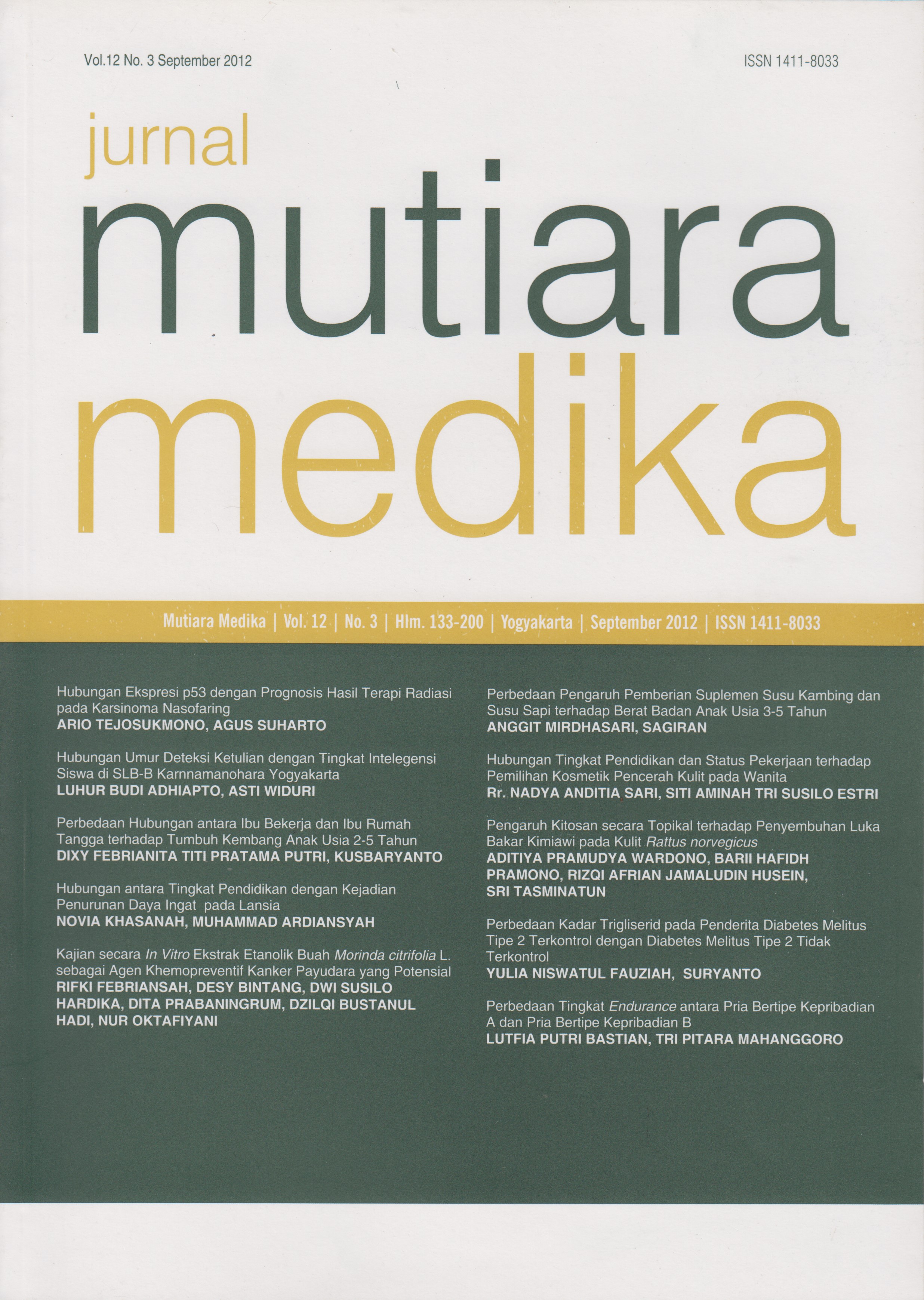Perbedaan Tingkat Endurance antara Pria Bertipe Kepribadian A dan Pria Bertipe Kepribadian B
DOI:
https://doi.org/10.18196/mmjkk.v12i3.1048Keywords:
endurance, VO2 max, personality type A and B, tipe kepribadian A dan BAbstract
Endurance atau daya tahan menyatakan keadaan yang menekankan pada kapasitas kerja secara terus menerus. Diartikan sama dengan kebugaran jasmani yaitu kemampuan seseorang menyelesaikan tugas sehari-hari tanpa mengalami kelelahan yang berarti. Daya tahan kardiorespirasi merupakan faktor utama dalam kebugaran jasmani. Pengukuran daya tahan kardiorespirasi untuk kapasitas aerobik dapat dilakukan dengan cara mengukur konsumsi oksigen maksimal (VO2max) . Penelitian ini bertujuan untuk melihat apakah terdapat perbedaan tingkat endurance antara pria bertipe kepribadian A dan pria bertipe kepribadian B. Penelitian menggunakan metode Astrand 6 minutes cycle test pada nilai VO2max dengan subyek sebanyak 60 pria yang terdiri dari 30 pria bertipe kepribadian A dan 30 pria bertipe kepribadian B. Data dianalisis menggunakan independent sample t test. Hasil penelitian didapatkan rerata nilai VO2max pada kelompok pria bertipe kepribadian A sebesar 31,8393 ± 2,14534 ml/ kg/ menit dan rerata nilai VO2max pada kelompok pria bertipe kepribadian B sebesar 36,3470 ± 3,15498 ml/ kg/ menit. Didapatkan perbedaan yang bermakna antara pria bertipe kepribadian A dan pria bertipe kepribadian B (p=0,000). Disimpulkan terdapat perbedaan tingkat endurance antara pria bertipe kepribadian A dan pria bertipe kepribadian B. Pria bertipe kepribadian A memiliki tingkat endurance yang lebih rendah dibandingkan pria bertipe kepribadian B.
Endurance is a condition that is showed continuous work capacity. Interpreted same as physical fitness is the ability of someone to complete everyday tasks without experiencing significant fatigue. Cardiorespiratory endurance is a main factor in physical fitness. Measurement of cardiorespiratory endurance for aerobic capacity can be done by measuring the maximal oxygen uptake (VO2max). The research aims to see if there are differences of endurance level between personality type A male and personality type B male. Research using the Astrand 6 minutes cycle test on the value of VO2max by as many as 60 male subjects consist of 30 male with personality type A and 30 male with personality type B. Data were analyzed using independent sample t test. Results showed the mean value of VO2max in the group personality type A male is 31.8393 ± 2.14534 ml/ kg/ min and the mean value of VO2max in the group personality type B is 36.3470 ± 3.15498 ml/ kg /min. Found significant differences between personality type A male and personality type B male (p = 0.000). The conclusion there are different levels of endurance between personality type A male and personality type B male. Male with personality type A have lower levels of endurance than male with personality type B.
References
Sajoto, M. Peningkatan dan Pembinaan Kekuatan Kondis Fisik dalam Olahraga. Semarang: Dahara Prize. 1988.
Giriwidjojo, S. Arti dan Fungsi Physical. Bandung: Universitas Padjadjaran. 1970.
Ichsan. Pendidikan Kesehatan dan Olahraga. Jakarta: DITKI. 1988.
Yunus, F. Faal Paru dan Olahraga. Jurnal Respirologi Indonesia, 1997; 17: 100 – 105.
Thomas, G. Theory of Physical Preparation for Volleyball. In: Coaches Manual 1. Lausanne: Federation International de Volleyball. 1989. Hlm : 400.
Fox, E.L., Mathew, D.K. The Physiology Basis of Education and Athletics. Philadelphia: Saunders College Publishing. 1981.
Astorin, T.A., Robergs, R.A., Ghiasvand, F., Marks, D., Burns, S. Incidence of the Oxygen Plateauat VO2max during Exercise Testing to Volitional Fatigue. J. of The Amer Soc of Exerc Physiol, 2000; 3 (4): 1-12.
Astrand. Text Book of Work Physiology. New York: McGraw-Hill. 1970.
Ogawa, T., Spinna, R.J., Martin, W.H., Kohrt, W.M., Schechtman, K.B., Holloszy, J.O., Ehsani, A.A. Effects of Aging Sex and Physical Taining on Cardiovascular Responses to Exercise. Circul. 1992; 86 (2): 494 - 503.
Astrand, P.O., Rodhahl, K. Textbooks of Work Physiology. 3rd Edition. New York: Mc GrawHill. 1986.
Kartawa, H. Kumpulan Diktat Kuliah Kedokteran Olahraga. Semarang: Fakultas Kedokteran Universitas Diponegoro, 2003. Hlm : 29 – 41.
Robbins, S.P. Organizational Behavior. New Jersey: Prentice Hall. 2003.
Friedman, M. Type A Behavior: Its Diagnosis and Treatment. New York: Plenum Press ( Kluwer Academic Press ). 1996.
Williams, R.B. Hostility: Effects on Health and the Potential for Successful Behavioral Approaches to Prevention and Treatment. In Baum, A., Revenson, T.A., Singer, J.E. (Eds.) Handbook of Health Psychology. Mahwah, NJ. 2001.
Sukadiyanto. Stres dan Cara Menguranginya. FKIK UNY, Yogyakarta. Cakrawala Pendidikan. Februari 2010. TH XXIX.
Ganong, W.F. Buku Ajar Fisiologi Kedokteran. Edisi 20. Alih bahasa: Widjajakusumah D., Irawati D., Siagian M., Moeloek D., Pendit B.U. Jakarta: EGC. 2002.
Loehr, J. Toughness Training for Life. New York: Penguin Books Ltd. 1993.
Downloads
Published
Issue
Section
License
Copyright
Authors retain copyright and grant Mutiara Medika: Jurnal Kedokteran dan Kesehatan (MMJKK) the right of first publication with the work simultaneously licensed under an Attribution 4.0 International (CC BY 4.0) that allows others to remix, adapt and build upon the work with an acknowledgment of the work's authorship and of the initial publication in Mutiara Medika: Jurnal Kedokteran dan Kesehatan (MMJKK).
Authors are permitted to copy and redistribute the journal's published version of the work (e.g., post it to an institutional repository or publish it in a book), with an acknowledgment of its initial publication in Mutiara Medika: Jurnal Kedokteran dan Kesehatan (MMJKK).
License
Articles published in the Mutiara Medika: Jurnal Kedokteran dan Kesehatan (MMJKK) are licensed under an Attribution 4.0 International (CC BY 4.0) license. You are free to:
- Share — copy and redistribute the material in any medium or format.
- Adapt — remix, transform, and build upon the material for any purpose, even commercially.
This license is acceptable for Free Cultural Works. The licensor cannot revoke these freedoms as long as you follow the license terms. Under the following terms:
Attribution — You must give appropriate credit, provide a link to the license, and indicate if changes were made. You may do so in any reasonable manner, but not in any way that suggests the licensor endorses you or your use.
- No additional restrictions — You may not apply legal terms or technological measures that legally restrict others from doing anything the license permits.






